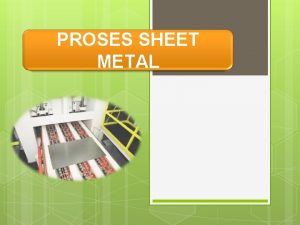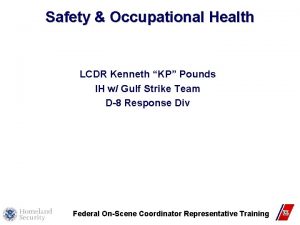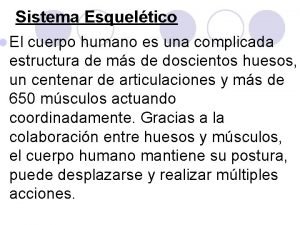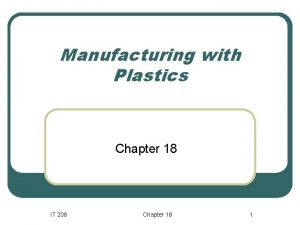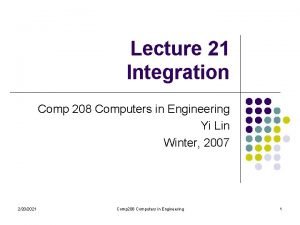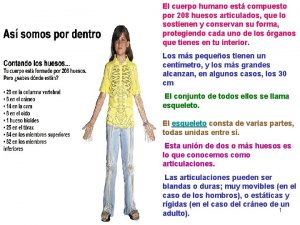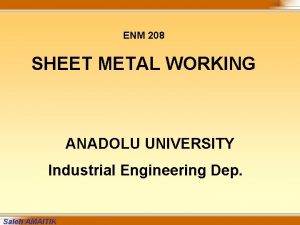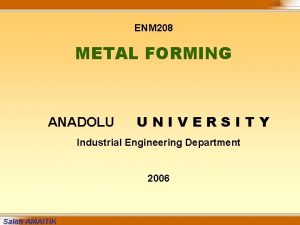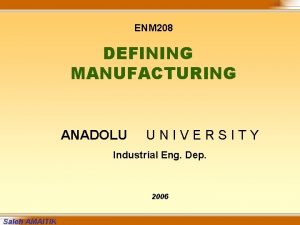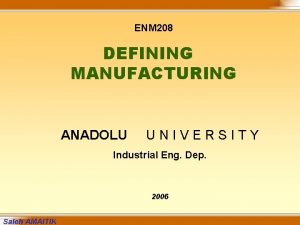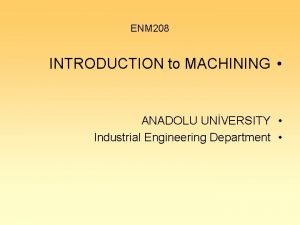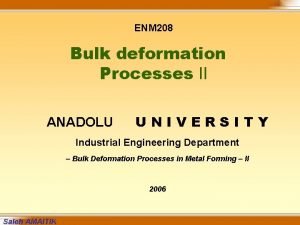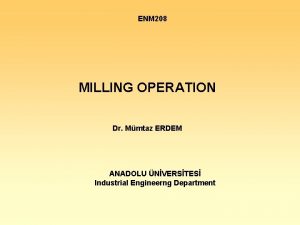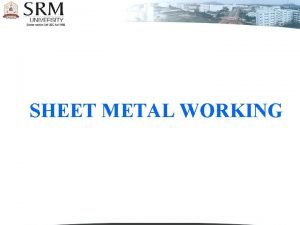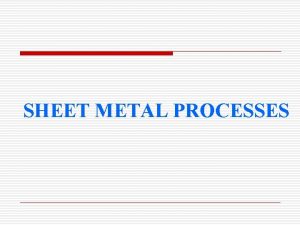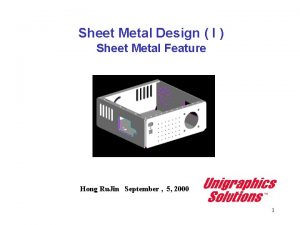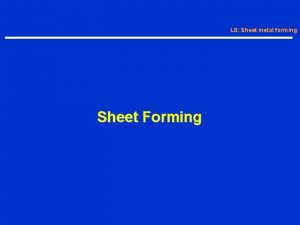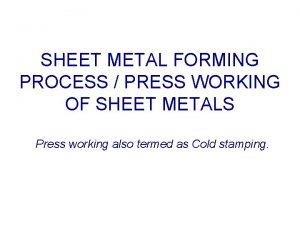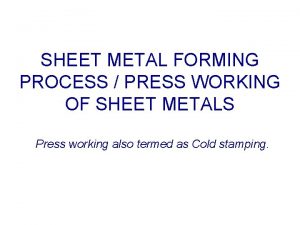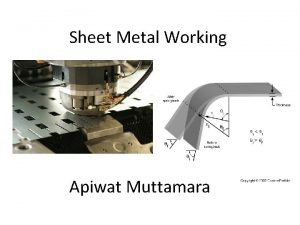ENM 208 SHEET METAL WORKING ANADOLU UNIVERSITY Industrial


















- Slides: 18

ENM 208 SHEET METAL WORKING ANADOLU UNIVERSITY Industrial Engineering Dep. Saleh AMAITIK

Manufacturing Processes Sheet Metalworking Sheet metalworking includes Cutting and Forming operations performed on relatively thin sheets of metal. Most sheet metal thicknesses are between 0. 4 mm and 6 mm. When thickness exceeds about 6 mm, the stock is usually referenced to as plate rather than sheet. Operations usually performed as cold working. Sheet and plate metal parts for consumer and industrial products such as - Automobiles and trucks - Farm and construction equipment Spring 2005 - Office furniture - Airplanes

Manufacturing Processes Advantages of Sheet Metal Parts • High strength • Good dimensional accuracy • Good surface finish • Relatively low cost • For large quantities, economical mass production operations are available Spring 2005

Manufacturing Processes Categories of Sheet Metalworking Processes The three major categories of sheet metal processes are: • Cutting – Shearing to separate large sheets; or cut part perimeters or make holes in sheets • Bending – Straining sheet around a straight axis • Drawing – Forming of sheet into convex or concave shapes Spring 2005

Manufacturing Processes Sheet Metalworking Terminology The tooling used to perform sheet metalwork is called Punch and Die. Most sheet metal operations are performed on machine tools called Presses. The term Stamping Press is used to distinguish these presses from forging and extrusion presses. The sheet metal products are called Stampings. Spring 2005

Manufacturing Processes Cutting Operations Cutting of sheet metal is accomplished by a shearing action between two sharp cutting edges. (1) just before the punch contacts work Spring 2005 (2) punch begins to push into work, causing plastic deformation

Manufacturing Processes Cutting Operations (3) punch compresses and penetrates into work causing a smooth cut surface Spring 2005 (4) fracture is initiated at the opposing cutting edges which separates the sheet

Manufacturing Processes Shearing, Blanking, and Punching There are three principal operations in pressworking that cut metal by shearing mechanism: • Shearing • Blanking • Punching Spring 2005

Manufacturing Processes Shearing Operation Shearing is a sheet metal cutting operation along a straight line between two cutting edges. (a) side view of the shearing operation (b) front view of power shears equipped with inclined upper cutting blade Symbol v indicates motion Spring 2005

Manufacturing Processes Blanking Operation Blanking involves cutting of the sheet metal along a closed outline in a single step to separate the piece from the surrounding stock. The part that is cut out is the desired product in the operation and is called the blank. Spring 2005

Manufacturing Processes Punching Operation Punching is very similar to blanking except that the piece that is cut is scrap, called the slug. The remaining stock is the desired part. Spring 2005

Manufacturing Processes Analysis of Sheet-Metal Cutting Clearance c Distance between punch and die. the Typical values range between 4% and 8% of stock thickness. Recommended clearance can be calculated by: c = at where c = clearance; a = allowance; and t = stock thickness - Allowance a is determined according to type of metal Die size determines blank size Db; Punch size determines hole size Dh. ; c = clearance Spring 2005

Manufacturing Processes Analysis of Sheet-Metal Cutting Allowance a for Three Sheet Metal Groups Metal group a Aluminum alloys 0. 045 Aluminum alloys; brass, soft cold rolled steel, soft stainless steel 0. 060 Cold rolled steel, half hard; stainless 0. 075 steel, half hard and full hard Spring 2005

Manufacturing Processes Analysis of Sheet-Metal Cutting Punch and Die Sizes for Blanking and Punching • For a round blank of diameter Db: – Blanking punch diameter = Db ‑ 2 c – Blanking die diameter = Db – where c = clearance • For a round hole of diameter Dh: – Hole punch diameter = Dh – Hole diameter = Dh + 2 c – where c = clearance Spring 2005

Manufacturing Processes Analysis of Sheet-Metal Cutting Forces Estimates of cutting force are important because this force determines the size of thee press needed. Cutting force in sheet metalworking can be determined by F=St. L where S = shear strength of metal (MPa); t = stock thickness (mm), and L = length of cut edge (mm) In blanking and punching operations, L is the perimeter length of the blank or hole being cut. Spring 2005

Manufacturing Processes Bending Operations Bending in sheet-metal work is defined as the training of the metal around a straight axis (a). During the bending operation, the metal on the inside of the neutral plane is compressed, while the metal on the outside of the neutral plane is stretched (b). Spring 2005

Manufacturing Processes Types of Bending Operations V‑bending performed with a V‑shaped die Spring 2005 Edge bending performed with a wiping die

Manufacturing Processes Drawing is a Sheet metal forming to make cup‑shaped, box‑shaped, or other complex‑curved, hollow‑shaped parts Sheet metal blank is positioned over die cavity and then punch pushes metal into opening (a) Drawing of a cup‑shaped part: (1) start of operation before punch (2) contacts work near end of stroke (b) Corresponding workpart: (1) starting blank (2) drawn part Spring 2005
 Proses flanging
Proses flanging Ics 208
Ics 208 Site:slidetodoc.com
Site:slidetodoc.com Verbals ending in -ing and used only as nouns are _____.
Verbals ending in -ing and used only as nouns are _____. Pl 107-208
Pl 107-208 Xkcd regex
Xkcd regex Level 2 pp. 208-210 answers
Level 2 pp. 208-210 answers Memory express
Memory express 136xe isotope
136xe isotope What is standard notation
What is standard notation Quizlet
Quizlet Nine section winding is
Nine section winding is 120/208 wye wye bank
120/208 wye wye bank Plastic compression molding
Plastic compression molding 208 rmb
208 rmb Comp 208
Comp 208 208 huesos
208 huesos Pa 208
Pa 208 Dns 208 67 222 222
Dns 208 67 222 222
